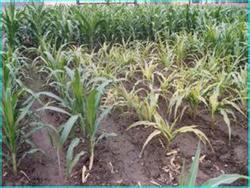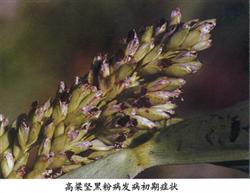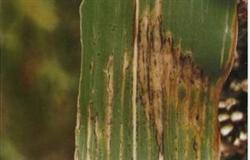Sorghum downy mildew

Symptoms the disease invades sorghum in a systematic or local form. It mostly harms the leaves. Chlorosis or light yellowish white areas appeared on the infected leaves at the seedling stage, and white mildew appeared on the back of the leaves when the humidity was high. Later, green and white parallel stripes appeared on the leaves, and finally light reddish brown stripes appeared. The chlorotic interveinal tissue turned into necrotic spots resulting in leaf rupture, which is a typical symptom of the disease. The plants infected at the seedling stage were dwarfed and died before flowering and fruiting, and those who could survive could not blossom. Although they could blossom in the later stage, the yield decreased sharply. Some diseased plants show clustered symptoms, which are very much like crazy tops. Sorghum is easy to induce purple spot after downy mildew. The tissue of the disease is not distorted or deformed and is different from mad top disease. The damage of the disease has an upward trend in recent years. The pathogen mildew refers to downy mildew, which belongs to flagellum subphylum fungi. The bacteria can infect corn as well as sorghum. The morphological characteristics of the pathogen can be seen in corn downy mildew. In addition, it has been reported that Sclerosporasorghi (kulk.) Westen et Uppal said that sorghum is a subphylum flagellate fungus, which is also the pathogen of the disease. The sporangium pedunculus of sorghum is erect, slightly inflated at the base, 100-150um long, the tip is bifurcated, the end is small pedicel tip, and the terminal sporangium protrudes from the stomata in the lower epidermis of the leaves. The sporangium is nearly round, papillless and colorless, with a size of 15 ~ 29 × 15 ~ 15 ~ 26.9 (um). It is born on a long and pointed peduncle. When the humidity is high, the sporangium germinates to form a bud tube. The ovary organ is spherical, 40-50um in size, buried in the mesophyll tissue between vascular bundles. The oospore is globose, colorless, with light yellow wall and 25-42.9um in size. Recently, it has been reported that Megaspora refers to a new variety of Phytophthora, which is also the pathogen of the disease. The mycelium is colorless, multinucleate and unsegregated. The ovary organ is subglobose, brown, and its size is 27 ~ 5mm 72.5 × 20 ~ 63.8 (um). 1-4 male organs, lateral, light yellowish brown, size 13, 18, 40.3 × 6.3 (um). The oospores are globose, yellowish brown and 23.8 mi 57.5 × 21 min 3mo 53.8 (um). The pathogen of transmission and disease conditions overwintered in the soil as oospores, and could survive for several seasons, and became the primary infection source of the disease the following year. Oospores germinate and produce germ tubes, which infect the leaves of seedlings. After the disease of seedlings, sporangia spread through wind and rain, and then re-infect. The sporangium germination needs high humidity and air temperature below 20 ℃. Under the field dry condition, the spores lose their vitality after 4 hours. Control methods (1) selection of disease-resistant varieties. (2) remove the sick and disabled body in time after harvest. (3) diseased plants were pulled out at any time and burned in the field. (4) large-scale crop rotation should be carried out in the seriously affected areas. (5) strengthen field management and timely drainage after rain to prevent moisture retention. (6) if necessary, spray 72% grams of frost cyanide or 72% Kelou wettable powder 700x liquid or 69% Anke manganese zinc wettable powder 1000 times liquid, 64% poison alum wettable powder 500x solution.
- Prev

Head smut of sorghum
Symptomatic diseased plants are shorter than healthy ones. At the initial stage of the disease, the ear bud of the diseased ear is very tight, the lower part is dilated, the flag leaf is straight, and the endophytic white rod can be seen, that is, Wumi. The black rice in the bracts is small at the beginning, finger-like, gradually growing, and the middle part of the posterior part is expanded into a cylindrical, harder. Wumi in the process of development, the internal tissue from white to black, after opening.
- Next

Sorghum black bundle disease
Symptomatic sorghum black bundle disease is a vascular bundle disease, also known as duct bundle blackening. When the leaf is obvious, brown stripes appear on the leaf vein, and there are large necrotic spots along one or both sides of the main vein, so that the leaf and leaf sheath become purple or brown, when the leaf is dry, the stem is a little thick, and there is branching in the upper part of the diseased plant. Cross-sectioning the diseased stem.
Related
- The first cup of black tea in spring, the flavor and history of tea gardens in Kenya, Africa
- The computer can not only choose potatoes, but also grow tea rice. AI will grow winter oolong tea champion.
- It is not only the inflated tea bitten by insects, but also engraved with the four seasons tea in Beipu.
- The Oriental Beauty Tea Festival in Zhuxian County takes the stage at the weekend to experience the plus-size feast of oil tea.
- & quot; Oriental Beauty Tea & Exploration of Emei in Hsinchu, the hometown of quot;
- The new variety of strawberry "Tainong 1" dessert is the first choice with mellow aroma. Crimson gorgeous
- History of Tea in Taiwan: from Wild Inner Mountain to Export Tea Garden
- Two types of Taiwan Oriental Beauty Black Tea won the British three-Star Award for Childhood Tea Xiang Zhang Jiaqi changed from pilot to champion tea maker.
- Banana species and varieties: the planting history of Taiwan Xianren banana and dwarf banana is long, is banana disease resistant?
- Coffee planting Technology: Qianjie Coffee from Seedling to harvesting

